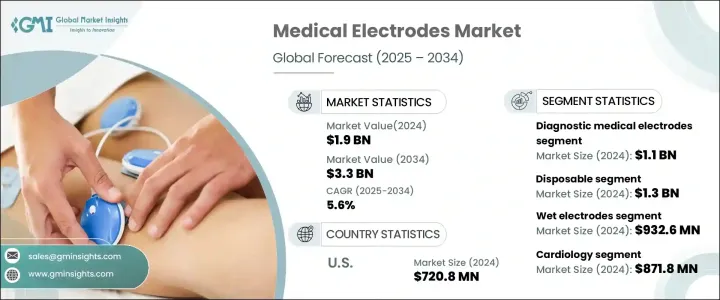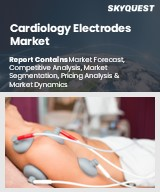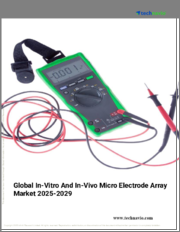
|
시장보고서
상품코드
1684765
세계의 의료용 전극 시장 : 기회, 성장 촉진요인, 산업 동향 분석, 예측(2025-2034년)Medical Electrodes Market Opportunity, Growth Drivers, Industry Trend Analysis, and Forecast 2025 - 2034 |
||||||
세계의 의료용 전극 시장은 2024년에 19억 달러로 평가되었고, 2025년부터 2034년까지 CAGR 5.6%를 나타낼 것으로 예측됩니다.
이 성장의 원동력은 심혈관 장애와 신경 장애와 같은 만성 질환의 유병률 증가, 웨어러블 의료기기의 채용률의 상승, 전극 기술의 진보입니다. 의료용 전극에 대한 수요는 비침습적인 진단 절차를 강조하고 지속적인 건강 모니터링의 필요성이 증가함에 따라 더욱 촉진되고 있습니다. 세계 건강 관리 시스템이 환자 결과를 개선하고 병원 진찰을 줄이는 데 중점을 두고 있기 때문에 의료용 전극을 웨어러블 기기 및 홈 케어 용도에 통합하는 기운이 높아지고 있습니다. 게다가, 이 시장은 정밀도, 환자의 안락함 및 전반적인 성과를 증가하는 전극 디자인의 혁신에서 이익을 얻고 있습니다. 선진국과 신흥국 시장 모두에서 건강 관리 지출 증가와 재택 관리로의 전환은 예측 기간 동안 시장 성장을 유지할 것으로 예상됩니다.

의료용 전극은 신체에서 진단 및 치료 장비로 전기 신호를 전송하는 데 필수적이며 심박수, 뇌파, 근육 수축과 같은 생리적 데이터를 얻는 데 중요한 역할을합니다. 이러한 장치는 심전도(ECG), 뇌파(EEG), 근전도(EMG), 제세동기 등의 응용 분야에서 널리 사용됩니다. 의료용 전극 부문은 다양한 의학적 상태 모니터링 및 진단에 널리 사용되는 것이 원동력이 되어 2024년에 11억 달러의 수익을 올렸습니다. 심혈관 질환과 신경 질환의 유병률이 증가함에 따라 진단용 전극 수요가 급증하고 있습니다. 이 전극은 건강 관리 제공업체가 초기 증상을 감지하고 적시에 치료를 보장하며 환자 결과를 개선합니다.
| 시장 범위 | |
|---|---|
| 시작 연도 | 2024년 |
| 예측 연도 | 2025-2034년 |
| 시작 금액 | 19억 달러 |
| 예측 금액 | 33억 달러 |
| CAGR | 5.6% |
2024년 9억 3,260만 달러의 수익을 차지한 습식 전극은 고품질 전기 신호를 전송하는 우수한 성능으로 시장을 독점하고 있습니다. 이러한 전극은 전도성 겔 또는 액체를 사용하여 피부와의 견고한 연결을 확립하고 최소한의 임피던스를 보장하며 EEG, ECG, EMG와 같은 진단 용도에 이상적입니다. 높은 신호 대 잡음비는 환자 모니터링의 정확성과 신뢰성을 향상시킵니다. 건식 전극 기술의 진보에도 불구하고, 습식 전극은 병원 환경에서의 장기 사용 및 TENS 및 신경근 자극과 같은 전기 치료 용도에 여전히 바람직한 선택입니다.
2024년에 13억 달러로 평가된 일회용 전극 부문은 편의성, 위생적 이점 및 비용 효과로 인해 큰 시장 점유율을 차지합니다. 일회용 전극은 일회용으로 설계되어 교차 오염의 위험이 없으며 응급실 및 수술실과 같은 대량의 의료 환경에 이상적입니다. 홈케어 용도과 웨어러블 헬스 모니터링 디바이스의 채용 확대에 의해 일회용 전극은 사용하기 쉬워 환자의 쾌적성을 향상시키기 때문에 더욱 수요가 높아지고 있습니다.
2024년 8억 7,180만 달러의 수익을 올린 심장병 부문은 2025년부터 2034년까지 연평균 복합 성장률(CAGR) 6%로 성장할 것으로 예측됩니다. 심혈관 질환의 세계 유병률 상승은 부정맥과 심근 경색과 같은 심장 질환의 진단 및 모니터링에 사용되는 전극 수요를 견인하고 있습니다. 무선 기능과 유연한 설계를 포함한 전극 기술의 혁신은 웨어러블 ECG 장비에 대해 응용을 확대하여 임상 환경 밖에서 실시간 심장 건강 모니터링을 가능하게 합니다.
가장 큰 최종 용도 부문인 병원은 2032년까지 20억 달러에 이를 것으로 예측됩니다. 급성 및 만성 질환을 관리하는 중요한 건강 관리 제공업체로서 병원은 진단 및 치료 용도의 의료용 전극에 크게 의존합니다. 실시간 환자 모니터링을 위한 웨어러블 전극 및 무선 전극의 채용이 증가하고 있어 병원 환경에서의 케어의 제공 효율을 높이고 있습니다.
미국에서는 의료용 전극 시장이 2024년에 7억 2,080만 달러의 수익을 차지했고, 2025년부터 2034년까지 CAGR 4.9%로 성장할 것으로 예상되고 있습니다. 확립된 헬스케어 시스템, 의료비 증가, 만성 질환의 유병률 증가가 이 지역 시장 성장을 가속하는 주요 요인입니다. 홈 헬스케어와 웨어러블 디바이스의 인기가 높아지고 전극 기술의 진보가 미국 시장의 확대를 더욱 추진하고 있습니다.
목차
제1장 조사 방법과 조사 범위
제2장 주요 요약
제3장 업계 인사이트
- 생태계 분석
- 업계에 미치는 영향요인
- 성장 촉진요인
- 만성 질환 증가
- 저침습 및 비침습진단에 대한 수요 증가
- 전극 설계와 재료의 기술적 진보
- 웨어러블 의료기기의 채용 확대
- 업계의 잠재적 위험 및 과제
- 생체 적합성과 환자의 쾌적성에 있어서의 과제
- 엄격한 규제 요건
- 성장 촉진요인
- 성장 가능성 분석
- 2024년 가격 분석
- 규제 상황
- 기술 상황
- 밸류체인 분석
- Porter's Five Forces 분석
- PESTEL 분석
제4장 경쟁 구도
- 소개
- 기업 매트릭스 분석
- 주요 시장 기업의 경쟁 분석
- 경쟁 포지셔닝 매트릭스
- 전략 대시보드
제5장 시장 추계 및 예측 : 제품 유형별, 2021-2034년
- 주요 동향
- 진단용 의료용 전극
- 심전도(ECG) 전극
- 뇌파(EEG) 전극
- 기타 진단용 전극
- 치료용 의료용 전극
- 제세동기용 전극
- 페이스메이커 전극
- 기타 치료용 전극
제6장 시장 추계 및 예측 : 기술별, 2021-2034년
- 주요 동향
- 습식 전극
- 건식 전극
- 바늘 전극
제7장 시장 추계 및 예측 : 사용성별, 2021-2034년
- 주요 동향
- 일회용
- 재사용 가능
제8장 시장 추계 및 예측 : 용도별, 2021-2034년
- 주요 동향
- 순환기
- 신경생리학
- 수면장애
- 기타 용도
제9장 시장 추계 및 예측 : 최종 용도별, 2021-2034년
- 주요 동향
- 병원
- 진단센터
- 기타 최종 사용자
제10장 시장 추계 및 예측 : 지역별, 2021-2034년
- 주요 동향
- 북미
- 미국
- 캐나다
- 유럽
- 독일
- 영국
- 프랑스
- 스페인
- 이탈리아
- 네덜란드
- 아시아태평양
- 중국
- 일본
- 인도
- 호주
- 한국
- 라틴아메리카
- 브라질
- 멕시코
- 아르헨티나
- 중동 및 아프리카
- 남아프리카
- 사우디아라비아
- 아랍에미리트(UAE)
제11장 기업 프로파일
- 3M
- Ambu
- B. Braun
- Boston Scientific
- Cardinal Health
- ConMed
- Dymedix Diagnostics
- GE Healthcare
- Medtronic
- Nihon Kohden
- Nissha Medical
- Philips Healthcare
- Rhythmlink
- Schiller AG
- ZOLL Medical
The Global Medical Electrodes Market was valued at USD 1.9 billion in 2024 and is projected to grow at a CAGR of 5.6% from 2025 to 2034. This growth is driven by the increasing prevalence of chronic diseases such as cardiovascular and neurological disorders, coupled with the rising adoption of wearable medical devices and advancements in electrode technology. The demand for medical electrodes is further fueled by the growing emphasis on non-invasive diagnostic procedures and the need for continuous health monitoring. As healthcare systems worldwide focus on improving patient outcomes and reducing hospital visits, the integration of medical electrodes in wearable devices and homecare applications is gaining momentum. Additionally, the market benefits from innovations in electrode design, which enhance accuracy, patient comfort, and overall performance. The increasing healthcare expenditure in both developed and developing regions, along with the shift towards at-home care, is expected to sustain market growth over the forecast period.

Medical electrodes, essential for transmitting electrical signals from the body to diagnostic or therapeutic equipment, play a critical role in capturing physiological data such as heart rate, brain waves, and muscle contractions. These devices are widely used in applications like electrocardiography (ECG), electroencephalography (EEG), electromyography (EMG), and defibrillators. The diagnostic medical electrodes segment generated USD 1.1 billion in revenue in 2024, driven by their extensive use in monitoring and diagnosing various medical conditions. With the rising prevalence of cardiovascular diseases and neurological disorders, the demand for diagnostic electrodes has surged. These electrodes enable healthcare providers to detect early symptoms, ensuring timely treatment and improving patient outcomes.
| Market Scope | |
|---|---|
| Start Year | 2024 |
| Forecast Year | 2025-2034 |
| Start Value | $1.9 Billion |
| Forecast Value | $3.3 Billion |
| CAGR | 5.6% |
Wet electrodes, which accounted for USD 932.6 million in revenue in 2024, dominate the market due to their superior performance in delivering high-quality electrical signals. These electrodes use conductive gel or liquid to establish a strong connection with the skin, ensuring minimal impedance and making them ideal for diagnostic applications like EEG, ECG, and EMG. Their high signal-to-noise ratio enhances the accuracy and reliability of patient monitoring. Despite advancements in dry electrode technology, wet electrodes remain the preferred choice for long-term use in hospital settings and electrotherapy applications such as TENS and neuromuscular stimulation.
The disposable electrodes segment, valued at USD 1.3 billion in 2024, holds a significant market share due to their convenience, hygiene benefits, and cost-effectiveness. Designed for single use, disposable electrodes eliminate the risk of cross-contamination, making them ideal for high-volume healthcare settings like emergency departments and operating rooms. The growing adoption of homecare applications and wearable health monitoring devices has further increased the demand for disposable electrodes, as they offer ease of use and improved patient comfort.
The cardiology segment, which generated USD 871.8 million in revenue in 2024, is anticipated to grow at a CAGR of 6% from 2025 to 2034. The rising prevalence of cardiovascular diseases globally drives the demand for electrodes used in diagnosing and monitoring heart conditions such as arrhythmias and myocardial infarctions. Innovations in electrode technology, including wireless capabilities and flexible designs, are expanding their applications in wearable ECG devices, enabling real-time heart health monitoring outside clinical settings.
Hospitals, the largest end-use segment, are projected to reach USD 2 billion by 2032. As critical healthcare providers managing acute and chronic conditions, hospitals rely heavily on medical electrodes for diagnostic and therapeutic applications. The increasing adoption of wearable and wireless electrodes for real-time patient monitoring is enhancing care delivery efficiency in hospital environments.
In the United States, the medical electrodes market accounted for USD 720.8 million in revenue in 2024 and is expected to grow at a CAGR of 4.9% from 2025 to 2034. The well-established healthcare system, rising healthcare expenditures, and increasing prevalence of chronic diseases are key factors driving market growth in the region. The growing popularity of home healthcare and wearable devices, along with advancements in electrode technology, further supports the expansion of the US market.
Table of Contents
Chapter 1 Methodology and Scope
- 1.1 Market scope and definitions
- 1.2 Research design
- 1.2.1 Research approach
- 1.2.2 Data collection methods
- 1.3 Base estimates and calculations
- 1.3.1 Base year calculation
- 1.3.2 Key trends for market estimation
- 1.4 Forecast model
- 1.5 Primary research and validation
- 1.5.1 Primary sources
- 1.5.2 Data mining sources
Chapter 2 Executive Summary
- 2.1 Industry 3600 synopsis
Chapter 3 Industry Insights
- 3.1 Industry ecosystem analysis
- 3.2 Industry impact forces
- 3.2.1 Growth drivers
- 3.2.1.1 Increasing prevalence of chronic diseases
- 3.2.1.2 Rising demand for minimally invasive and non-invasive diagnostic procedures
- 3.2.1.3 Technological advancements in electrode design and materials
- 3.2.1.4 Growing adoption of wearable medical devices
- 3.2.2 Industry pitfalls and challenges
- 3.2.2.1 Challenges in biocompatibility and patient comfort
- 3.2.2.2 Stringent regulatory requirements
- 3.2.1 Growth drivers
- 3.3 Growth potential analysis
- 3.4 Pricing analysis, 2024
- 3.5 Regulatory landscape
- 3.6 Technology landscape
- 3.7 Value chain analysis
- 3.8 Porter’s analysis
- 3.9 PESTEL analysis
Chapter 4 Competitive Landscape, 2024
- 4.1 Introduction
- 4.2 Company matrix analysis
- 4.3 Competitive analysis of major market players
- 4.4 Competitive positioning matrix
- 4.5 Strategy dashboard
Chapter 5 Market Estimates and Forecast, By Product Type, 2021 – 2034 ($ Mn)
- 5.1 Key trends
- 5.2 Diagnostic medical electrodes
- 5.2.1 Electrocardiography (ECG) electrodes
- 5.2.2 Electroencephalography (EEG) electrodes
- 5.2.3 Other diagnostic electrodes
- 5.3 Therapeutic medical electrodes
- 5.3.1 Defibrillator electrodes
- 5.3.2 Pacemaker electrodes
- 5.3.3 Other therapeutic electrodes
Chapter 6 Market Estimates and Forecast, By Technology, 2021 – 2034 ($ Mn)
- 6.1 Key trends
- 6.2 Wet electrodes
- 6.3 Dry electrodes
- 6.4 Needle electrodes
Chapter 7 Market Estimates and Forecast, By Usability, 2021 – 2034 ($ Mn)
- 7.1 Key trends
- 7.2 Disposable
- 7.3 Reusable
Chapter 8 Market Estimates and Forecast, By Application, 2021 – 2034 ($ Mn)
- 8.1 Key trends
- 8.2 Cardiology
- 8.3 Neurophysiology
- 8.4 Sleep disorders
- 8.5 Other applications
Chapter 9 Market Estimates and Forecast, By End Use, 2021 – 2034 ($ Mn)
- 9.1 Key trends
- 9.2 Hospitals
- 9.3 Diagnostic centers
- 9.4 Other end users
Chapter 10 Market Estimates and Forecast, By Region, 2021 – 2034 ($ Mn)
- 10.1 Key trends
- 10.2 North America
- 10.2.1 U.S.
- 10.2.2 Canada
- 10.3 Europe
- 10.3.1 Germany
- 10.3.2 UK
- 10.3.3 France
- 10.3.4 Spain
- 10.3.5 Italy
- 10.3.6 Netherlands
- 10.4 Asia Pacific
- 10.4.1 China
- 10.4.2 Japan
- 10.4.3 India
- 10.4.4 Australia
- 10.4.5 South Korea
- 10.5 Latin America
- 10.5.1 Brazil
- 10.5.2 Mexico
- 10.5.3 Argentina
- 10.6 Middle East and Africa
- 10.6.1 South Africa
- 10.6.2 Saudi Arabia
- 10.6.3 UAE
Chapter 11 Company Profiles
- 11.1 3M
- 11.2 Ambu
- 11.3 B. Braun
- 11.4 Boston Scientific
- 11.5 Cardinal Health
- 11.6 ConMed
- 11.7 Dymedix Diagnostics
- 11.8 GE Healthcare
- 11.9 Medtronic
- 11.10 Nihon Kohden
- 11.11 Nissha Medical
- 11.12 Philips Healthcare
- 11.13 Rhythmlink
- 11.14 Schiller AG
- 11.15 ZOLL Medical



















